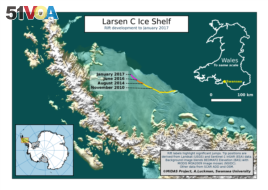15 January, 2017
Researchers say part of a very large shelf of ice on Antarctica could soon break off – and become an iceberg.
A team of scientists is closely watching part of the Larsen Ice Shelf, off the coast of northwestern Antarctica. The area is connected to land, but floats on seawater instead of sitting on top of the continent.

Larsen C Ice Shelf showing break line. Courtesy MIDAS Project.
The piece of ice, known as Larsen C Ice Shelf, caught the attention of researchers a few years ago. There are many cracks, or signs of weakness, in the ice. In 2010, the scientists found that one crack was getting bigger.
Martin O'Leary is with Swansea University in Wales. He spoke with VOA about the work he does with Project MIDAS, the British group studying Antarctica.
"We became concerned in 2014 when it started to become obvious that this crack was going to produce a particularly large iceberg, much larger than we had initially expected."
Icebergs are huge masses of ice that break off from glaciers in coastal areas. Glaciers begin as fallen snow. Over time, the weight of the snow creates large, thickened ice masses. When the ice becomes too heavy, pieces break off and float in the sea.
The crack on the Larsen C Ice Shelf has been growing quickly -- by an estimated 18 kilometers just in the second half of December.
And how large will this future iceberg be?
Martin O'Leary thinks it will be between nine to 12 percent of the ice shelf, which is about the size of some countries.
The iceberg will be "around 5,000 square kilometers," he says.
That would be about the size of Lebanon. Now, only 20 kilometers of ice still connects the iceberg to the shelf.
What is causing the break?
By nature, ice is brittle and can break easily. O'Leary says the process that is opening the large crack is a natural one.
"The crack is a natural phenomenon, the ice by its nature is quite brittle, it tends to crack quite a lot. What happens is that snow and bits of debris fall into the crack and that pushes the crack open even wider, so the force of that crack ratchets the crack open and that's what causes it to get longer and longer."
He adds that "to the best of our knowledge," this break is not a product of climate change. Some studies have linked rising temperatures to human activities.
The new iceberg is not expected to change ocean levels around the world. That is because the iceberg is already sitting in the sea and it will not displace more water.
Once it breaks off, the iceberg will slowly move away. Over time, it will break into smaller pieces, which will move north, and eventually melt away.
What is the Larsen Ice Shelf?
The Larsen Ice Shelf is a series of shelves, all of which are linked together. They may be connected to the land, but float out over the sea. They grew out from the Antarctic mainland over tens of thousands of years. And over time, pieces have broken off.
Larsen A, the most northern and smallest part, broke free from the continent in 1995.
There was the larger Larsen B Ice Shelf. It was an estimated 3,200 square kilometers of ice, and about 220 meters thick. But it broke up into the sea in 2002.
Now, Larsen C is larger still, with ice thickness averaging 350 meters. This is where the piece is that is about to break off of the ice shelf.
O'Leary says "the honest answer is we don't know" when the iceberg will break off. But scientists think it will probably be in the next few months.
While they call this a "natural process," O'Leary explains that this break could make the area more vulnerable to climate change in the future.
"What we're worried about is that this will put the ice shelf in a more unstable position, which will mean that the effects of climate change, such as melting of the ice, thinning of the ice, those can have a stronger effect now."
And that means there could be more events like this one, with large parts of the ice shelf falling into the sea. It could lead to the collapse of the whole shelf.
There is not enough information to predict if or when that might happen. But if it does, it is possible that the ice, which the Larsen shelf holds on the land, could start sliding into the sea.
Predictions suggest that could raise world sea levels by as much as 10 centimeters.
I'm Anne Ball.
Kevin Enochs wrote this story for VOA News. Anne Ball reported this story for Learning English. George Grow was the editor.
We want to hear from you. Write to us in the Comments Section and visit us on 51VOA.COM.
_______________________________________________________________
Words in This Story
crack – n. a line in the surface of something that is broken but not separated into pieces
obvious – adj. easy to see or notice
initially – adv. occurring at the beginning of something
phenomenon – n. something that can be observed and studied that is unusual or difficult to understand or explain fully
ratchet – v. to increase or decrease something by a series of small amounts
vulnerable – adj. easily hurt or harmed physically, mentally or emotionally